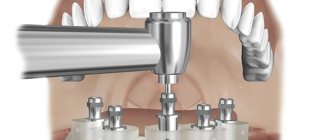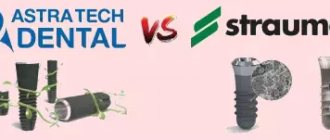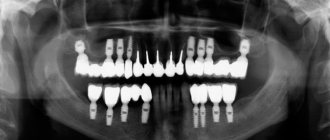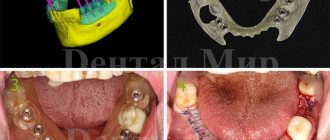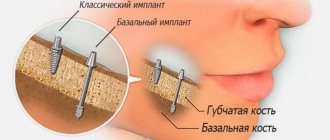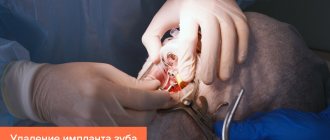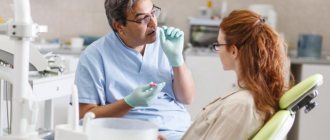The all on 4 method is implantation in the complete absence of teeth in the jaw, when a fixed bridge prosthesis is fixed to only 4 titanium supports. Prosthetics are performed no later than 72 hours after the implantation surgery, which allows patients to restore their teeth in record time.
The all on 4 technique is based on the unique properties of titanium. The metal is capable of merging with human bone tissue and forming a single, strong structure. The healing process is called osseointegration.
Nobel-Biocare, after further improvements to the titanium surface, achieved a uniquely rapid fusion of titanium and jaw bone tissue and in 1998 announced the all-on-4 protocol - “All on 4 implants”.
All-on-4: the essence of the protocol
The patient has 4 dental titanium implants surgically implanted into the bone tissue of the toothless jaw. Based on the casts, a permanent prosthesis is prepared, which is installed almost immediately. The first artificial jaw is temporary. It is worn for 5-36 months - it all depends on the design and material of the prosthesis. Then the orthopedic product is replaced with a new one, which the patient wears for decades.
Implantation ol he 4: features of the technique
All on four - implantation with wide possibilities. Thanks to a simplified method of implantation and prosthetics, tens of thousands of patients were able to restore the natural functions of their teeth and a beautiful smile.
The all on 4 protocol is based on the use of only 4 dental implants. They are the basis of the system, its main advantage. But also the one-stage “all on 4” implantation method is:
- computer planning
— an implant surgeon evaluates bone tissue density based on CT and 3D modeling results, selects optimal points for implantation without harming nearby anatomically important structures;
- inclined installation of 2 lateral implants
— titanium screws are implanted into the distal parts of the jaw at an angle of 30-45 degrees, which increases the area of contact between artificial roots and bone tissue and guarantees uniform load distribution;
- direct installation of a second pair of implants in the anterior jaw
— stabilization of the system, increasing its strength and convenience for patients;
- use of Multi-Unit abutments
— a special adapter system compensates for the difference between the installation angle of the titanium rod and the denture, which allows the artificial jaw to be placed anatomically correctly and comfortably for the patient.
Advantages over the classical method, as well as disadvantages of the method
The treatment concept under consideration has many undeniable advantages. The main advantages of the technique are listed below:
- use for complete edentia: the All-on-4 dental prosthetic technology has proven itself to be excellent in restoring the entire dentition. In addition, the method is successfully used in cases where the deplorable condition of the remaining teeth requires their removal,
- quick smile restoration: these are teeth that can actually be obtained in just 1 day. The complete treatment process takes up to 4-5 days on average,
- the ability to achieve impeccable aesthetics: implants serve as supporting elements for the installation of modern orthopedic structures that meet high aesthetic standards,
- additional protection against aging: fixing the prosthesis immediately after implantation allows you to restore tone to the facial muscles and thereby prevent premature aging, which inevitably occurs when several or all teeth in a row are missing. It has been proven that after dental restoration, wrinkles are smoothed out,
- no need for bone augmentation: installation of the structure at an angle makes it possible to use a large area of bone material, so preliminary bone augmentation, as a rule, is not required, or is carried out simultaneously with implantation,
- excellent stability indicators: the use of deep and denser bone sections, as well as the use of elongated zygomatic implant models for the upper jaw, guarantees high primary stability,
- restoration of the condition of bone tissue: almost simultaneous installation of implants and prostheses makes it possible to stop the rapid reduction in bone tissue volume, which is a natural consequence of tooth loss and entails uneven distribution of the load,
- the most accurate placement of implants: thanks to computer modeling and the use of special templates, it is possible to significantly reduce the risk of making mistakes during the operation.
Using computer modeling, it is possible to calculate the most accurate placement of implants
. Despite the impressive list of advantages, the use of this protocol is possible only if there is a slight loss of bone volume. The fact is that if there is an acute shortage of it, such a number of implants will not be enough to securely fix the prosthesis. Otherwise, after a fairly short period of time, the entire system will lose its functionality under the influence of increased loads. For this reason, in case of acute bone tissue deficiency, it is still worth paying attention to alternative solutions to the problem. For example, for a protocol on six dental implants or basal implantation in general, where the number of supports is increased to 120-12 pieces per row.
Advantages of All-on-4 implantation
Benefits of choosing the all on 4 implantation method in comparison with the two-stage traditional protocol:
- small number of installed implants
— only 4 for fixing a full jaw prosthesis versus 6-10 implants using classical technology;
- instant installation of a full-fledged fixed prosthesis
— there is no need to wait for the implants to take root and endure inconvenient removable structures;
- minimum surgical steps
— when prosthetics are performed on 4 implants, the implants are placed without bone grafting, and the two-stage protocol often requires additional bone tissue augmentation;
- optimal survival rate
— for the all-on-4 protocol, implants with survival rates of more than 92% are used, and modern technologies and the professionalism of doctors increase this parameter to 98-99%;
- treatment speed
— an experienced implantologist needs no more than 2-3 hours to implant all four implants and preliminary remove the patient’s teeth if necessary.
Dental implantation using the all on 4 method is also actively compared with removable prosthetics. The advantages of the one-step protocol in this case are undeniable:
- Simple hygiene - fixed dentures are cleaned like regular teeth, there are no special conditions for storage, rinsing, or care.
- Convenience and comfort of use - artificial teeth “All on 4” have titanium roots and are tightly fixed in the mouth. The denture does not fall out, does not rub the gums, and does not interfere with speaking. The all on 4 system completely replaces regular teeth.
- Simple adaptation - adaptation lasts literally a few days and is associated with the restoration of the sensations of a full set of teeth in the oral cavity.
- The taste of dishes is preserved - the basis of removable systems distorts taste perception; a fixed all-on-four prosthesis is completely free of this drawback.
All on 4: disadvantages
The negative aspects of the “all-on-fo” protocol are very conditional:
- Contraindications
. There are limitations in any implantation option, but a thorough examination and a competent doctor help reduce the risks. In critical cases, the implantologist selects an alternative option for comfortable prosthetics.
- High demands on the professionalism of a doctor
. The all on 4 technique requires careful calculations, mastery of surgical techniques, and a competent assessment of any emerging situation. It’s easy to find a good implantologist who specializes in the “all-on-4” protocol based on doctor ratings.
- Loose bone tissue in a patient
. For the upper jaw, the problem is solved by selecting Nobel Zygoma zygomatic dental implants; for the lower jaw, by accurately calculating the time of all on 4 prosthetics.
Features of dental care after treatment
The prosthetic structure is attached with a screw, which means that only the treating specialist can remove it, for example, for relining. Therefore, caring for a new smile after prosthetics with 4 implants does not involve any special manipulations or procedures. You will need to maintain a proper level of hygiene, brush your teeth twice daily, rinse your mouth every time after eating and regularly visit the dentist for preventive purposes.
Experts in the field of dentistry and implantology, in particular, recommend purchasing an additional brush and irrigator for better cleansing of plaque and food debris. Immediately after surgery, the chewing load should be increased gradually. At the same time, you will have to give up too much solid food, flying, visiting baths and saunas, and intense physical activity for a while.
Prosthetics using the all on 4 system: who is it suitable for?
Photos of teeth “all on 4 implants” can be seen in different patients. This indicates the versatility of the technique and its wide popularity. The concept solves many dental and aesthetic problems of patients - radically, once and for all. All-on-4 can only be performed if there is a sufficient amount of jaw bone tissue. If there is severe atrophy or bone deficiency, the doctor will suggest alternative options.
All on 4 dental implantation technology is indicated if:
- completely edentulous
- all teeth are missing on one or even both jaws;
- partial edentia
— many teeth in the upper or lower jaw are missing, and the remaining ones must be removed due to mobility or disease;
- intolerance to removable dentures
- discomfort, gag reflex, allergic reaction to artificial teeth materials;
- contraindications to bone grafting
— bone augmentation is not possible for medical reasons.
Also, the all on 4 concept attracts patients who choose an economical and reliable implantation option for themselves. In this case, the issue is resolved directly with the implant surgeon. The doctor assesses the condition of problem teeth, conducts diagnostics, and decides on the possibility of implanting four titanium pins to install a fixed prosthesis.
All on 4 implants, if there are accompanying indications, are suitable for almost all patients who do not smoke, do not have serious diagnoses or dysfunctions of the endocrine and cardiovascular systems and monitor their oral health. If all this is present, the “all on four” protocol will be allowed for use.
Prices and reviews for all-on-4 dentures are very attractive. And more and more patients are interested in the all on 4 technique, seeking to restore a full set of teeth before truly serious problems arise with the gums and bone tissue.
Alternative solutions
- on six: this technique is widely used for moderate degrees of bone tissue atrophy. The use of this number of implants instead of four allows for reliable fixation of the orthopedic structure,
Implantation according to the All-an-6 protocol - basal protocol: the optimal solution to the problem of complete edentia. In this case, up to 12 implants are installed, which are fixed in the deep layers of bone tissue, protected from atrophy. This method is relevant for situations where the bone volume is very small.
But you shouldn’t even consider classical implantation if you need to restore all the teeth in a row. There is not enough bone for implants, and extension is not possible. This is very difficult (for such a volume) and expensive.
Single-stage implantation all on four: stages of prosthetics
Dental implants can be inserted in Moscow on a turnkey basis at different prices. In most cases, the cost is influenced by the volume of work performed, the type of dental implants, the experience and demand of the doctor. Dental clinics offer ready-made packages of services, which may differ significantly from each other. In order not to make a mistake and subsequently pay extra for important examinations and manipulations, the patient must know the stages of the “all on four” protocol.
All on 4 prosthesis: photos and features of ceramic composite
Usually there are only three main steps of all on 4 implantation:
- Preparatory.
- Surgical.
- Orthopedic.
In fact, the correct all-on-fo implantation protocol consists of six steps:
- Preparation, diagnostics.
- Implantation.
- Installation of an adaptive fixed prosthesis.
- Rehabilitation after surgery.
- Hygienic stage.
- Replacing a temporary denture with a permanent one.
Prices and promotions for dental implantation in Moscow directly depend on what stages of all on 4 the dental clinic takes into account, so it is worth considering the treatment in as much detail as possible.
Preparation for all-on-4 implantation surgery
The preparatory stage begins with diagnosis. Without an examination, no doctor will recommend implantation or select an implant manufacturer.
Examinations are necessary to exclude contraindications and plan treatment. Usual appointments for the patient:
- OPTG
— panoramic photo;
- CT
— 3D model, computed tomography result;
- standard set of analyzes - UAC
,
OAM
,
blood biochemistry.
If necessary or if there are certain diagnoses, the implantologist will refer the patient to a specialist for permission, an ECG and additional examinations. The decision is made individually according to the collected medical history.
In the photographs, the doctor will look at the volume and structure of the bone tissue of the jaws. This will be followed by computer planning, calculation of implantation points, and in some cases, production of a surgical template.
Simultaneously with building a treatment strategy, the doctor assesses the risks and gives prognoses for all-on-4 implantation. The result directly depends on the volume of preserved bone tissue - the more, the better. Experienced doctors know that ideal implant healing is guaranteed if:
- width of the alveolar ridge of the jaw - from 5 mm;
- the height of the bone tissue at the implantation point is 10 mm.
If the tests are good, the doctor agrees with the patient on the date of the operation and sends him to take impressions of the teeth, which will later serve as the basis for the manufacture of a denture.
All on 4 surgical protocol
The implementation of this stage depends on two points - the anesthesia chosen by the patient and the presence of teeth in the jaw.
Implantation is an unpleasant but fairly painless procedure, so it is usually performed under local anesthesia. However, the patient can choose to have all-on-4 implanted under sedation or anesthesia—in a state of drug-induced sleep. Artificial sleep makes the treatment unnoticeable and quick, eliminating anxiety and nervousness. Treatment during sleep is recommended for patients with dental phobia or other indications. The rest tolerate the procedure well under local anesthesia.
The presence of teeth in the jaw obliges the doctor to remove the remaining units before implantation. Then the surgeon immediately proceeds to installing artificial roots, implanting them at pre-planned points at precise angles.
Prices and reviews of all on 4 technology often lead to patients having both jaws restored at once. This can be done at one time, but the duration of the operation increases slightly. The effectiveness of such treatment is much higher than sequential implantation, since upon completion of all stages the patient becomes the owner of a full bite - two jaws with beautiful, even teeth.
Installation of a temporary adaptive prosthesis
While the surgical stage is underway or after it, a temporary adaptive fixed prosthesis is made for the patient in a dental laboratory. There are many requirements placed on him, as he must:
- completely replace the patient’s teeth until a permanent structure is installed;
- ensure normal, but not excessive load on implants and bone tissue - for rapid engraftment of artificial titanium roots;
- be comfortable, aesthetic, functional.
Temporary teeth are made of acrylic plastic with or without a metal frame. The presence of a beam determines the cost of the orthopedic structure, its durability and reliability. The metal base also affects the timing of fixation of the prosthesis on dental implants - immediately or after a few days.
The difference between the products is obvious:
Temporary denture without frame
- It is given to the patient directly on the day of all-on-4 implantation surgery.
- The operating life of the system is moderate - up to six months with mandatory replacement with a permanent option.
- The main advantage of the model is the price.
- The main disadvantages are fragility, high risk of breakage.
- The frameless option is not suitable for patients with bruxism or increased tone of the masticatory muscles.
Adaptive dental frame prosthesis
- Fixation on implants is performed 2-3 days after surgery, since dental technicians take longer to produce this orthopedic product.
- The metal frame guarantees the durability of artificial teeth - up to 2-3 years of trouble-free wearing.
- Advantages: durability, reliability, removal of all dietary restrictions.
- The disadvantage is the price.
Postoperative stage: recovery, recommendations
The all-on-4 surgical stage is almost always successful, but even an ideal operation requires follow-up monitoring by a doctor.
Patients are recommended:
- come for examination 1-2 times over the next 10 days - assess the condition of the gums, remove sutures, check the quality of healing;
- Gradually load the implants - eat moderately hard foods, slowly increase the chewing load.
Also, after implantation according to the all-on-4 protocol, the patient is required to follow the mandatory postoperative instructions:
- gentle brushing of teeth - using dental floss and mouthwash;
- calm rhythm of life - rest for the first 3-5 days after implantation;
- giving up smoking and alcohol - otherwise there may be difficulties with the implantation and general well-being.
Professional hygiene of an adaptive prosthesis
This stage is required for all temporary frame prostheses with a long wearing period. Its essence is professional cleaning and polishing of orthopedic structures in dentistry every six months. To do this, the doctor unscrews the 4 screws that secure the product to the implants, removes the denture and puts it in order. Then he fixes the artificial teeth back onto the implants.
Maintenance of the temporary structure by many clinics is included in the cost of turnkey all-on-4 implantation, but sometimes this is a separately paid procedure. To avoid incidents and unnecessary expenses, it is worth clarifying this point in advance.
Permanent prosthetics with all-on-fo implantation
After the implants have healed and the service life of the adaptive prosthesis has expired, the design is replaced with a permanent product. The patient himself chooses what exactly he will wear - based on material, price, aesthetics.
All-on-4 implantation is always the installation of an artificial jaw on 10-12 teeth, which is enough to ensure a beautiful smile and complete restoration of chewing functions. Larger structures for 12-14 teeth require 6 dental implants to be firmly fixed using the all-on-6 protocol.
Stage surgery (implantation).
In our clinic, we recommend installing implants using this technique using a surgical template. This auxiliary template makes it possible to install implants on a toothless jaw (where there are no landmarks for the former position of already lost teeth) with absolute accuracy, to be sure within a fraction of a millimeter of the correct position and angle of inclination of the installed implants.
The principle of the surgical template is that it is made in advance using individual impressions of the oral cavity; using 3D technology, guide holes are created in it, which perfectly correspond to the size and position in the jaw of the future direction of the implants. It is also possible to install implants without a template.
If all teeth are removed, then on the day of surgery, 4 implants are installed in strictly specified positions. Provided that there are still teeth that need to be removed, the surgeon removes them immediately before the implantation procedure.
Implants for 4: what the prosthesis looks like - materials
In the photo, the dentures on 4 implants look different. Some are natural, like real teeth, others are simpler. Main materials used in prosthetics:
- metal ceramics;
- zirconium dioxide;
- ceramic composite.
What are the global differences between artificial jaws made of different materials - pros and cons, characteristics.
Metal ceramics for all-on-4 prosthetics
Metal-ceramics is familiar to everyone who has ever thought about inserting a tooth on a turnkey basis.
This is the most inexpensive and aesthetic material in orthopedic dentistry. It is chosen for single prosthetics with crowns and for the manufacture of a full-fledged artificial jaw. Advantages of metal ceramics for all-on-4 prosthesis:
- Excellent physical and mechanical properties.
Cobalt chromium alloy is used as a metal component. It is characterized by high resistance to deformation, strength, and reliability. - Quite a long service life
- dentures made of metal ceramics last up to 10 years. - Affordable cost
- in comparison with zirconium crowns, the cost of the orthopedic stage will be 1.5-2 times lower.
Metal-ceramics also have disadvantages:
- risk of developing allergic or galvanic reactions;
- slightly unnatural appearance, poor aesthetics;
- If repairs are necessary, the entire prosthesis must be removed for restoration in the laboratory.
Zirconium metal-free permanent all on 4 design
Metal-free orthopedic structures are indistinguishable from real teeth.
They not only reliably imitate crowns and enamel, but also form an ideal gum contour for “all-on-4” prosthetics. Advantages of zirconium products:
- Aesthetics and believability
. No one will be able to distinguish artificial zirconium teeth from real ones. - Mechanical strength
. Higher than that of metal-ceramic prostheses, which guarantees the reliability and integrity of the system when worn. - Biocompatibility with human tissues
. The material does not cause allergic reactions or gum irritation. Due to the absence of metal in the crowns, the risk of galvanization is eliminated. - Durability of wearing
. Zirconium dioxide is inert to food dyes and odors, does not deform or collapse, and lasts for decades without repair or replacement.
Disadvantages of the all-on-4 zirconia prosthesis:
- High price.
All on 4 prosthesis: photos and features of ceramic composite
Ceramic-composite dentures are used quite often for all-on-4 implantation.
The reasons are simple:
- Ideal aesthetics of real teeth
. Layer-by-layer application of polymer during the manufacture of a prosthesis ensures the natural color of the enamel and natural light transmission. - Resistant to food coloring
. There is no need for even the slightest restrictions after installing teeth using the “all on 4” protocol. - Strength, reliability
. Ceramic composite has a low level of wear. - Convenient, quick repair without removing dentures
. Any chip can be easily restored using ceramic composite material.
Flaws:
- The high price of a titanium-based prosthesis - especially if premium segment implants are chosen for all-on-4.
- Careful daily care - good oral hygiene using a irrigator to eliminate the risk of plaque forming from inside the crowns.
Pros and cons of “All on 4” technology
| pros | Minuses |
| restoration of chewing function and smile aesthetics in 1-3 days | the ability to chew is fully restored after a month |
| the cost is almost 2 times lower compared to classical implantation methods | the price of treatment with original materials is quite high |
| rehabilitation is easier for patients to tolerate | not used for extreme bone atrophy |
| bone grafting is not required in most cases |
All on 4 or all on 6: what are the differences
The all-on-four protocol is recommended for patients with complete or partial edentia. In this case, some atrophy of bone tissue is acceptable - weak or moderate. If there is not enough bone material to stabilize the implants, then the doctor will consider a similar protocol with an increased number of implanted artificial roots - all-on-6.
This is an improved technique that involves the installation of 6 dental implants. The standard scheme is the implantation of implants in the tooth position 6-4-2|2-4-6. This guarantees uniform load on the bone, high primary stability of the system, and strength of fixation. It also allows the use of dentures with an increased number of crowns.
When restoring the upper jaw, doctors often use extended zygomatic implants. This helps to bypass anatomically dangerous areas and ignore atrophied bone tissue.
What are the advantages of dental prosthetics with 4 implants?
If we compare the “All on Four” technique with the use of removable dentures, the difference will be that in the first case the risks of mucosal injury, bone loss, as well as difficulties with fixation and correction are reduced to zero.
A patient with a removable denture experiences discomfort both functionally and socially. Most people who use removable dentures experience some self-doubt, and sometimes even inferiority in their social status. Also, when installing “all on four” implants, as already mentioned, there is no need for a large number of implants. Due to the fact that these four implants are installed in certain positions in relation to each other: when implanting the front teeth - straight, and in the lateral teeth - at an angle of 35º to 45º, and also by creating a large distance between them, the chewing load is adequately distributed and is redistributed during operation. A small number of implants simplifies the operation, making it faster and more predictable, while ensuring excellent results.
How much does it cost to install a dental implant in Moscow on a turnkey basis: full price of the service
You can get teeth placed on implants in Moscow at different prices. The promotional price starts from 140 thousand rubles for one jaw and includes all basic services. The minimum price is focused on the use of budget OSSTEM or Implantium implants with survival rates of 92-95%.
Maximum success is guaranteed by premium brands - Straumann and Nobel Biocare, but the price using implants from these manufacturers increases by 2-2.5 times.
Regular turnkey package:
- free consultation;
- surgical stage for installation of 4 implants;
- orthopedic stage - installation of a standard denture.
All other services must be negotiated additionally - as part of the offered package or at an additional cost.
All teeth in one day
This type of procedure, also known as “teeth in a day” or instant implantation, is an innovative system designed to give you a completely new and natural-looking smile in one visit to the dentist.
Varieties
Sign up for a consultation with our specialists in Moscow. We successfully install several types of prostheses:
- Acrylic - an aesthetic and economical option, using pink plastic and three-layer teeth;
- Metal-ceramic - a prosthesis with a high level of strength due to the titanium base and ceramic-composite facing part;
- Metal-free – the design is lightweight and physiological. Thanks to the BioHPP material, a high level of aesthetics is achieved.
The final cost is also influenced by the amount of treatment required (tooth extraction, caries elimination) before surgery and the type of prosthetic materials.
All on 4 implantation: what’s the catch with the low price
When figuring out how much it costs to insert a dental implant in Moscow, many patients pay attention to unrealistically low prices. What is the catch with cheap services and what you need to pay attention to when choosing all on 4 implantation in metropolitan clinics:
- Savings on prosthesis and implantation components
.
A dental implant is usually a prefabricated structure that directly includes a titanium screw and an abutment adapter. The product is loaded with a denture on top. Saving on abutments and prosthetics reduces the cost of “all-on-four” implantation, but poses risks later. Potential problems include numerous corrections, broken abutments, frequent repairs of dentures, allergies to the material, staining of crowns.
- Inexpensive implants
.
Ratings of dental implants introduce patients to numerous series of different price ranges. But the all-on-4 protocol was created exclusively for Nobel Biocare. Today, series of all premium brands, products of the South Korean company OSSTEM, and the Dentium Implantium line are adapted to the “all on 4” concept. All other implants are a risk for the patient.
- Partial provision of services
.
To increase the attractiveness of all-on-4 implantation, many clinics indicate the price not “turnkey”, but for one stage - usually for dental surgery. The patient pays for everything else independently. The risk of such a situation can be reduced by clarifying the specific services in the package and carefully studying the contract, which specifies the fixed final price and its components.
- Inexperienced doctors
.
To reduce prices and attract patients, a number of clinics invite young implantologists. The patient saves, and the doctors learn to do quality work. Participation in such a “project” is a lottery with rare winnings.
Having decided to take care of your own health, you should not save on all-on-4 implantation. The consequences and risks are much more serious than they initially seem.
Do dentures require special care?
Any orthopedic structure in the oral cavity requires special care and attention. By ensuring the proper level of hygiene, you can significantly extend the life of the product. The structures installed after implantation of artificial roots using the All-on-4 system are no exception in this regard. Artificial teeth also require systematic double cleaning with a brush and toothpaste, the use of brushes and an irrigator for even better cleaning of hard-to-reach places, and periodic disinfection using special pharmaceutical solutions.
In the interval between the denture and the gum, it is imperative to pay great attention to care
It is important to understand that this protocol involves the restoration of all teeth. This means that the initial situation in the patient’s oral cavity is not good enough - there is inflammation of the gums, the level of gum and bone is completely uneven. That is why dentures have a small contour made of plastic - this is, so to speak, artificial gum. And it does not fit quite tightly - there is a rinsing gap left, which allows for high-quality hygiene. It is precisely this area between the prosthesis and the gum that must be given great attention from a hygiene point of view, so that plaque does not accumulate here and inflammation of the mucous membrane does not occur, which can lead to implant rejection.
Alternatives to all-on-4 implantation
The most popular alternative to all-on-4 implantation is the all-on-6 protocol. A larger number of implants, stability and also a fairly favorable price. But it happens that both concepts are not suitable for patients - for financial or other reasons.
Then the dental clinic offers alternative solutions for the complete restoration of the dentofacial line:
- Fixed dental bridge
. For strong fixation, it requires the presence of supporting healthy teeth and can sufficiently replace missing units externally and functionally.
- Removable dental prosthesis
. It has virtually no contraindications and is very inexpensive. But even one made from the most modern materials differs from all-on-4 implantation in increased discomfort in wearing and maintenance. Increases the risk of rapid bone tissue atrophy.
- Prosthesis on 6-10 implants
. The doctor uses a classic two-stage implantation protocol. The patient needs to be prepared for significant expenses and long-term wearing of a removable denture. The permanent structure will be installed only after the artificial titanium roots have completely engrafted.
- Basal implantation
. A special feature of the technique is the use of implants that reach the basal bone during installation. The basal bone is dense, not prone to atrophy, and supports implants well. The method is recommended for smokers, as well as for patients with diabetes.
All-on-4 implantation guarantees a full mouth of teeth in the shortest possible time. A safe, comfortable method of treating adentia and other dental problems. You can select a clinic for a profitable operation with a promotion and an experienced implant surgeon in the corresponding ratings on the 1dentist website.
“All on four” implantation: fast and effective smile restoration
“All on four” is an independent treatment protocol that can be used to restore only a full row of teeth.
If a person is missing only a few teeth, then the method will not work. Or it is suitable if the teeth are sick and need to be removed. This concept has been actively used in dentistry for more than 20 years. The system was first used in 1998, when a specialist from Portugal, Paulo Malo, successfully used the All-on-41 technology during treatment. Important information! This method was developed by Nobel. The name of the protocol is registered and is a trademark.



